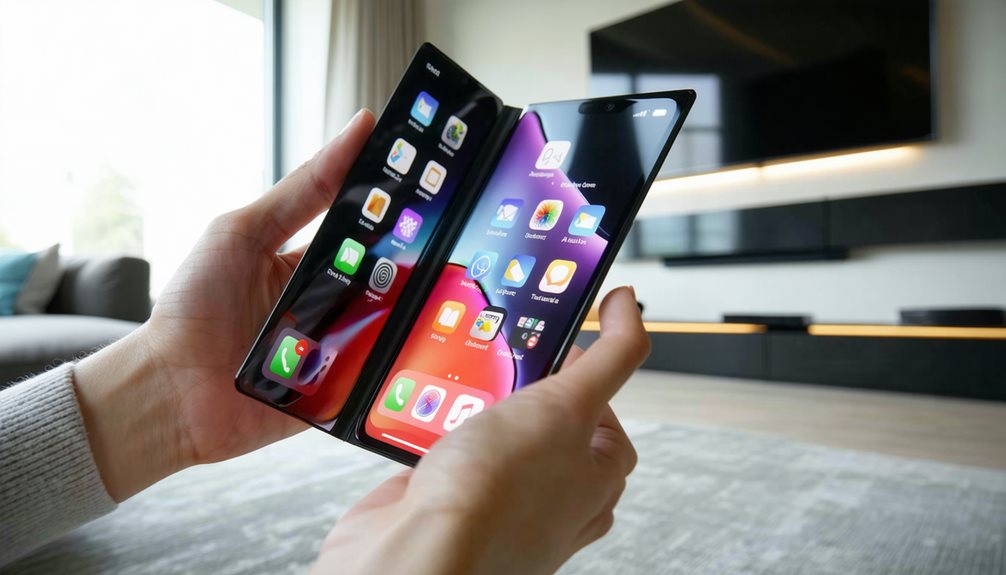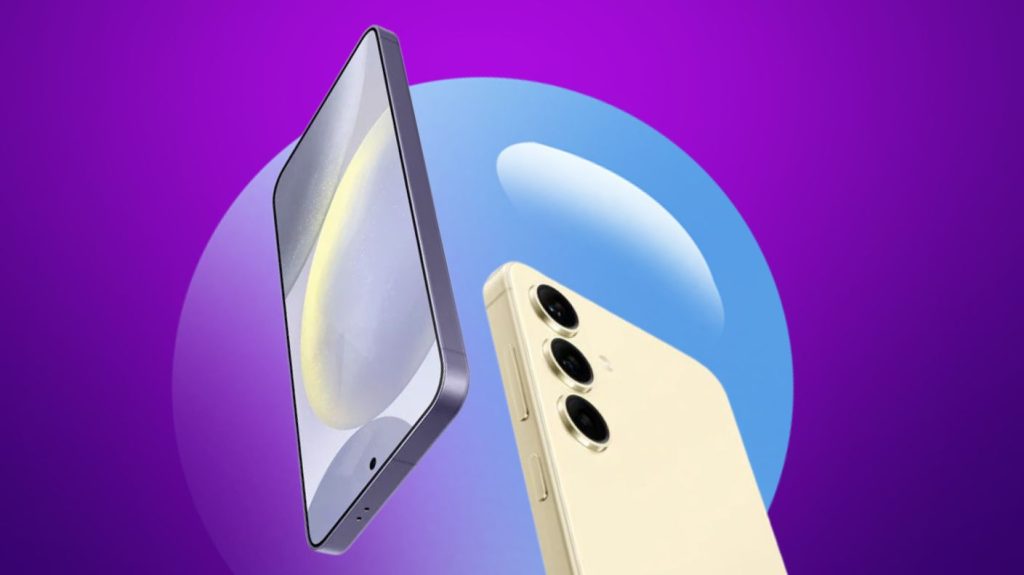Are Foldable Smartphones Worth It in 2025? Pros, Cons, and Key Innovations
Investing in foldable smartphones is like having a Swiss Army knife in your pocket. You get the innovation of a device that switches between phone and tablet modes, offering larger displays for enhanced multitasking.
But, here’s the catch: they come with a heftier price tag. Durability and battery life can be a bit of a gamble, too. These complex designs might lead to costly repairs or quicker depreciation, much like a luxury car.
Yet, don’t let that put you off completely. The market is evolving, with technology improving and prices expected to drop, much like the once-pricey flat-screen TVs.
If you’re curious about where these cutting-edge devices might fit into your life, there’s a whole world to explore. Dive in and see if a foldable smartphone could be your next tech companion.
Pros and Cons of Foldable Smartphones: Are They a Smart Choice?

You’re likely wondering if foldable smartphones are worth the investment, considering their unique advantages and potential drawbacks. While they offer the allure of larger displays and a sleek, portable design, they also come with concerns about durability and higher costs compared to traditional phones. Understanding how these devices stack up against conventional models will help you decide if their benefits outweigh the limitations.
Advantages of Foldable Smartphones
While traditional smartphones have long dominated the market, foldable smartphones bring a new level of versatility that’s hard to ignore. Foldable phones offer enhanced versatility by seamlessly shifting between phone and tablet modes. Their larger screens and multitasking capabilities improve user experiences and productivity. With a compact design, these innovative features position foldable smartphones as a game-changer in the smartphone industry, appealing to those seeking cutting-edge technology.
Disadvantages of Foldable Phones
Despite the allure of cutting-edge technology, foldable smartphones present several notable drawbacks that potential buyers should consider. They’re more expensive than traditional phones, with a high price point often exceeding $1,000. Limited battery life and less durable designs, including complex hinge mechanisms, require careful handling. Repair options are costly, and app optimisation struggles can lead to inconsistent performance, diminishing the user experience.
How Do Foldable Smartphones Compare to Traditional Phones?
Contemplating the disadvantages of foldable phones, it’s important to weigh how they stack up against traditional smartphones. A foldable phone might offer more screen real estate, but normal phones win in durability and app optimisation. Regular phones are often cheaper and lighter, but are they worth it? Here’s what to reflect on:
- Screen size vs. portability
- Price differences
- Durability concerns
- Limited app optimisation
- User experience
Durability: How Long Do Foldable Smartphones Last?

When you’re considering a foldable smartphone, durability is a key factor to keep in mind. The folding mechanism and hinge design play vital roles in how long these devices last, with some models experiencing wear and tear quicker than traditional phones. By understanding common durability issues and exploring available solutions, you can make a more informed decision about whether a foldable phone is the right investment for you.
How the Folding Mechanism Affects Durability
As you explore the world of foldable smartphones, it’s important to understand how the folding mechanism impacts durability. Durability concerns arise from:
- Hinge mechanisms: Prone to wear, affecting hinge reliability.
- Fragile flexible screens: Susceptible to scratches and breaks.
- Engineering innovations: Aim to enhance overall longevity.
- Dust and water resistance: Often lacking, increasing wear risks.
- User experiences: Highlight varied performance in reliability.
Hinge Design and Build Quality in Foldable Phones
Understanding the durability of foldable smartphones involves examining the hinge design and build quality, as these elements are vital to the phone’s lifespan. Advanced multi-axis hinges boost durability, though lifespan evaluations reveal varied results based on user habits. Manufacturers continually enhance these designs, but water resistance remains limited. Regular maintenance is essential, as dust intrusion can impair hinge performance, emphasising the need for careful handling.
Common Durability Issues and Solutions
Despite their cutting-edge appeal, foldable smartphones come with inherent durability challenges that could affect their longevity. You’ll face:
- Fragile flexible screens prone to damage.
- Hinge reliability issues causing wear and tear.
- Lack of dust and water resistance, making them vulnerable to environmental factors.
- The necessity for careful handling to prevent damage.
- The importance of protective cases to extend device lifespan.
Are Foldable Smartphones a Good Investment?

When considering foldable smartphones, you should weigh their higher cost against traditional models to determine if they’re worth the investment. While these devices offer advanced features and long-term value, their resale potential is another factor to keep in mind. Evaluating whether foldables maintain their worth over time can guide your decision-making process.
Cost Comparison: Foldable vs. Traditional Smartphones
While foldable smartphones captivate tech enthusiasts with their innovative design and multitasking capabilities, their cost can be a significant consideration. The premium pricing often doubles that of a traditional smartphone, reflecting advanced features but also posing:
- Durability concerns
- Battery life challenges
- Enhanced multitasking capabilities
- Larger displays for better productivity
- High cost compared to traditional models
Weigh these factors carefully in your cost comparison.
Long-Term Value of Owning a Foldable Phone
As you compare the costs of foldable and traditional smartphones, it’s important to contemplate the long-term value that these innovative devices offer. Foldable smartphones, with their advanced functionality and larger screens, promise significant long-term value. As durability improves and repair costs drop, consumer interest and market expansion will drive price reductions. This evolution guarantees foldables become a more viable and appealing investment over time.
Resale Value: Do Foldables Hold Their Worth?
How do foldable smartphones stack up regarding resale value, and are they a wise investment for the future? They face higher depreciation rates, largely due to emerging technology and durability concerns. Potential buyers might be hesitant because of:
- Durability concerns
- High depreciation rates
- Limited repair options
- Niche market appeal
- Competition driving prices down
Yet, their allure to tech enthusiasts could enhance resale potential.
User Experience: How Do Foldable Phones Change the Way We Use Smartphones?

With foldable smartphones, you’re introduced to a new domain of usability, offering larger screens for multitasking without sacrificing portability. However, adapting to the unique folding interfaces can be challenging, as not all apps are optimised for this design, potentially affecting your interaction. Embracing foldable screens changes how you engage with content, encouraging creativity and offering innovative ways to use your device.
Benefits of Foldable Design for Usability
While traditional smartphones have long dominated the market, foldable designs are revolutionising the user experience by offering unparalleled versatility. Enjoy a larger display area for multitasking capabilities and a compact design that doesn’t compromise on screen size. Benefit from:
- A versatile user experience
- Hands-free video calls
- Foldable-friendly applications
- Innovative design for creative uses
- Seamless shift between smartphone and tablet modes
Challenges with Folding Phone Interfaces
As foldable smartphones offer a fresh take on usability, they also introduce unique challenges in user experience that can’t be overlooked. You might enjoy multitasking on larger screens, but app optimisation remains inconsistent, potentially causing frustration. Software bugs and delayed security updates can further disrupt your experience. Additionally, visible creases impact visual aesthetics, highlighting the need for compatibility improvements to truly master this technology.
How Foldable Screens Affect User Interaction
Foldable screens are revolutionising user interaction by dramatically enhancing multitasking capabilities. You can seamlessly switch between smartphone and tablet modes, enjoying an expanded viewing area for immersive experiences. Embrace the advantages of:
- Split-screen functionality for running multiple apps.
- Stylus support for creative tasks.
- A compact design that maximises portability.
- Portable displays fitting easily in your pocket.
What’s New in the Foldable Smartphone Market in 2025?

In 2025, you’ll find exciting developments in the foldable smartphone market, with new models offering impressive features and innovations. Keep an eye on the latest Samsung Galaxy Z series and its competitors, which showcase cutting-edge advancements like ultra-thin glass and improved battery efficiency. As more apps become optimised for flexible screens, these devices are set to provide an even better user experience at increasingly competitive prices.
Upcoming 2025 Foldable Models to Watch
Though the foldable smartphone market has seen rapid evolution, 2025 promises to be a landmark year with exciting new models hitting the scene. You’ll see:
- Ultra-thin glass improving durability and user experience.
- Energy-efficient designs extending battery life.
- Advanced hinge mechanisms enhancing flexibility.
- More apps optimised for foldable screens.
- Lower price of foldable smartphones due to increased production.
Stay ahead with these upcoming 2025 foldable models!
Latest Technological Advancements in Foldables
As 2025 unfolds, the foldable smartphone market is buzzing with remarkable technological advancements set to redefine user experience. You’ll see ultra-thin glass technology boosting durability and enhanced hinge mechanisms minimising screen creases. Improved battery technologies address multitasking demands, while higher refresh rates and unique functionalities elevate your interaction. The expanding app ecosystem further enhances your foldable smartphone journey, ensuring you’re always ahead with cutting-edge innovation.
Case Study: Samsung Galaxy Z and Leading Competitors
With the foldable smartphone market poised for expansion, Samsung Galaxy Z and its leading competitors are pushing the boundaries with new innovations in 2025. You’ll find:
- Innovative features enhancing multitasking and user experience.
- Durability improvements via advanced hinge mechanisms and ultra-thin glass.
- Affordable foldable models attracting wider consumer interest.
- Competitors driving market growth with unique offerings.
- App optimisation providing seamless experiences on foldable screens.
Who Should Buy a Foldable Smartphone?
Ever wondered who should consider buying a foldable smartphone? If you thrive on multitasking and productivity, foldable smartphones with larger displays are your ideal companions. Tech enthusiasts will love exploring their innovative design. Enjoy multimedia content with enhanced viewing. Professionals in creative fields can sketch effortlessly. Plus, if you value portability, these devices provide a compact solution without compromising screen size.
Future of Foldable Smartphones: What’s Next?

Looking ahead, the future of foldable smartphones promises exciting advancements that could transform the way you interact with technology. Expect:
- Ultra-thin glass technology: Boosts durability and minimises screen damage.
- Energy efficiency: Enhances battery life for multitasking in flex mode.
- Innovative hinge mechanisms: Improves performance and longevity.
- Price reductions: Makes devices more accessible to everyone.
- Expanded app ecosystem: Optimises experiences for foldable screens.
Final Thoughts: Are Foldables Here to Stay?
While foldable smartphones might have once seemed like a fleeting trend, their growing global shipments and consumer interest tell a different story. Enhanced durability and innovative designs are winning over consumers, proving their multitasking capabilities indispensable. As the competitive market expands, prices are expected to drop, boosting consumer acceptance. With the smartphone market shifting, foldables appear poised to remain a staple of modern technology.
Final Thoughts
Thinking about getting a foldable smartphone, are you? Well, let’s have a chinwag about the ups and downs of these fancy gadgets. They’re pretty nifty, I must say! Versatile and portable, they are, letting you juggle tasks like a pro. But hang on a sec, there are a few things you might want to mull over first. Durability? Bit iffy, some say. And the price tag? Not exactly pocket change. Oh, and apps? Not all are made to fit these bendy screens just yet.
Feeling adventurous and keen to hop on the tech bandwagon? A foldable might just tickle your fancy. As tech marches on, these might become as common as a cup of tea. But before you part with your hard-earned dosh, have a gander at what you really need and what your piggy bank can handle.





